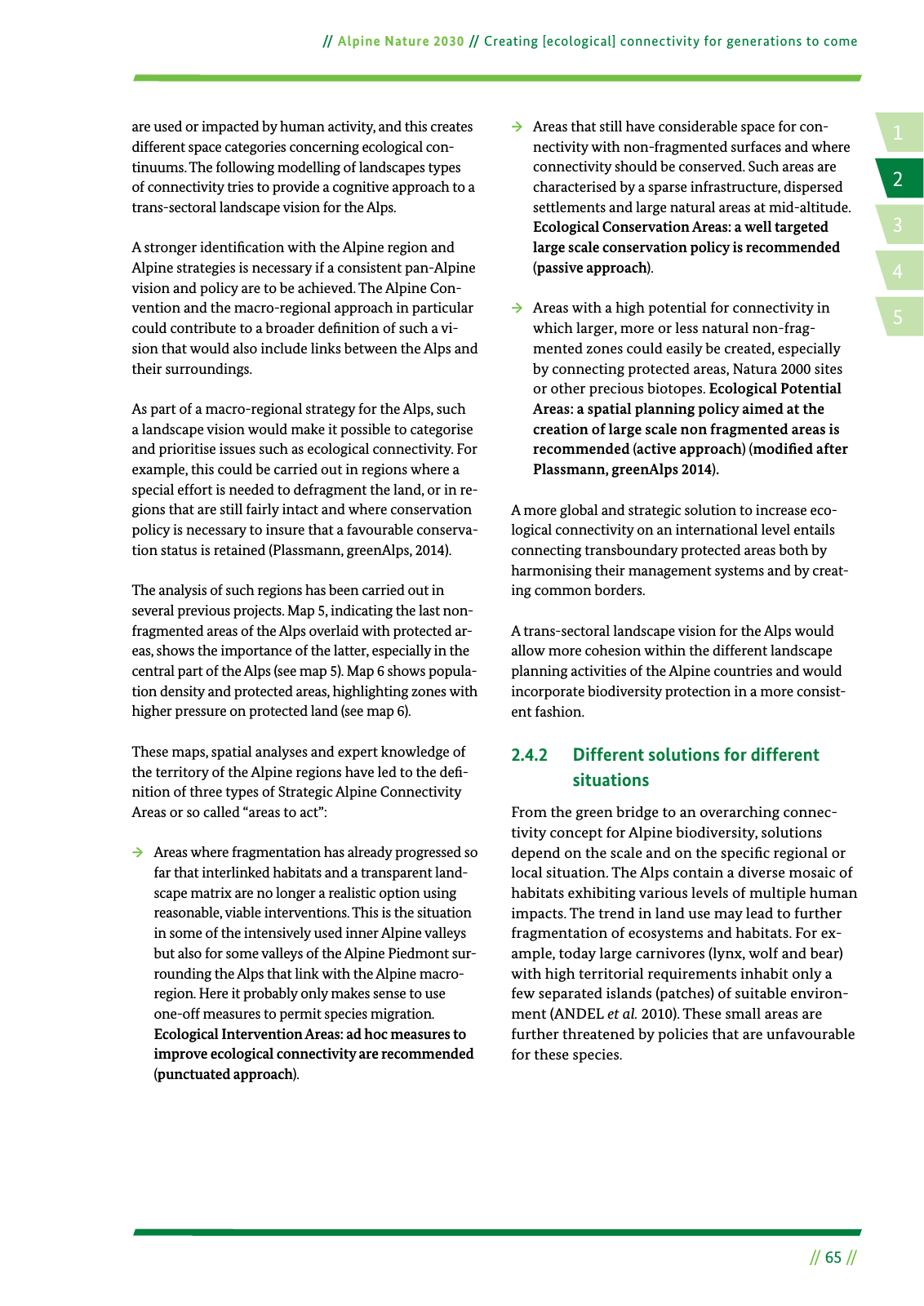14 2 5 3 65 Alpine Nature 2030 Creating ecological connectivity for generations to come are used or impacted by human activity and this creates different space categories concerning ecological con tinuums The following modelling of landscapes types of connectivity tries to provide a cognitive approach to a trans sectoral landscape vision for the Alps A stronger identi cation with the Alpine region and Alpine strategies is necessary if a consistent pan Alpine vision and policy are to be achieved The Alpine Con vention and the macro regional approach in particular could contribute to a broader de nition of such a vi sion that would also include links between the Alps and their surroundings As part of a macro regional strategy for the Alps such a landscape vision would make it possible to categorise and prioritise issues such as ecological connectivity For example this could be carried out in regions where a special effort is needed to defragment the land or in re gions that are still fairly intact and where conservation policy is necessary to insure that a favourable conserva tion status is retained Plassmann greenAlps 2014 The analysis of such regions has been carried out in several previous projects Map 5 indicating the last non fragmented areas of the Alps overlaid with protected ar eas shows the importance of the latter especially in the central part of the Alps see map 5 Map 6 shows popula tion density and protected areas highlighting zones with higher pressure on protected land see map 6 These maps spatial analyses and expert knowledge of the territory of the Alpine regions have led to the de nition of three types of Strategic Alpine Connectivity Areas or so called areas to act Areas where fragmentation has already progressed so far that interlinked habitats and a transparent land scape matrix are no longer a realistic option using reasonable viable interventions This is the situation in some of the intensively used inner Alpine valleys but also for some valleys of the Alpine Piedmont sur rounding the Alps that link with the Alpine macro region Here it probably only makes sense to use one off measures to permit species migration Ecological Intervention Areas ad hoc measures to improve ecological connectivity are recommended punctuated approach Areas that still have considerable space for con nectivity with non fragmented surfaces and where connectivity should be conserved Such areas are characterised by a sparse infrastructure dispersed settlements and large natural areas at mid altitude Ecological Conservation Areas a well targeted large scale conservation policy is recommended passive approach Areas with a high potential for connectivity in which larger more or less natural non frag mented zones could easily be created especially by connecting protected areas Natura 2000 sites or other precious biotopes Ecological Potential Areas a spatial planning policy aimed at the creation of large scale non fragmented areas is recommended active approach modi ed after Plassmann green Alps 2014 A more global and strategic solution to increase eco logical connectivity on an international level entails connecting transboundary protected areas both by harmonising their management systems and by creat ing common borders A trans sectoral landscape vision for the Alps would allow more cohesion within the different landscape planning activities of the Alpine countries and would incorporate biodiversity protection in a more consist ent fashion 2 4 2 Different solutions for different situations From the green bridge to an overarching connec tivity concept for Alpine biodiversity solutions depend on the scale and on the speci c regional or local situation The Alps contain a diverse mosaic of habitats exhibiting various levels of multiple human impacts The trend in land use may lead to further fragmentation of ecosystems and habitats For ex ample today large carnivores lynx wolf and bear with high territorial requirements inhabit only a few separated islands patches of suitable environ ment ANDEL et al 2010 These small areas are further threatened by policies that are unfavourable for these species

Hinweis: Dies ist eine maschinenlesbare No-Flash Ansicht.
Klicken Sie hier um zur Online-Version zu gelangen.
Klicken Sie hier um zur Online-Version zu gelangen.